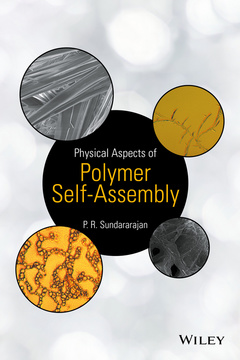Physical Aspects of Polymer Self-Assembly
Auteur : Sundararajan P. R.

Offering an overview of principles and techniques, this book covers all major categories of self-assembled polymers ? properties, processes, and design. Each chapter focuses on morphology, applications, and advanced concepts to illustrate the advantages of polymer self-assembly across industrial and academic research.
? Provides an organized, comprehensive overview of polymer self-assembly, its fundamentals, principles, and applications
? Includes chapters on block copolymers, amphiphilic polymers, supramolecular polymers, rotaxenes, polymer gels, dendrimers, and small molecules in polymer matrices
? Focuses on novel applications, block copolymer assembly to nanotechnology, photonics and metamaterials, molecular machines and artificial muscle, gels that can be applied to polymer science, materials science, and nanotechnology
? Examines state-of-the-art concepts, like lithographic patterning and foldaxane
? Discusses challenges and future outlook of a popular and emerging field of study
Preface xi
1 Introduction 1
1.1 Polymer Tacticity 1
1.2 Big versus Small 5
1.3 Entanglement 5
1.4 Excluded Volume 8
1.5 Free Volume 10
1.6 Self‐Assembly 10
1.7 Polymer Self‐Assembly 12
References 13
2 Molecular Forces 17
2.1 Van der Waals Interaction 17
2.2 Hydrogen Bond 21
2.3 C─H…π Interaction 27
2.4 Halogen Bond 29
2.5 Other Hydrogen Bonds 30
2.6 Coulombic Interaction 31
References 33
3 Features of Self‐Assembly 37
3.1 Self‐Sorting—Small Molecules 37
3.2 Polymer Self‐Sorting 43
3.3 Concentration‐Dependent Association 48
3.4 Polymer–Guest Molecule Recognition 49
3.5 Sergeant–Soldier Phenomenon 55
3.6 Majority Rules 61
3.7 Chain Folding 65
3.8 Foldamers 79
3.9 Single Chain Polymer Crystals and Nanoparticles 91
References 99
Further Reading 104
4 Supramolecular Macromolecules and Polymers 105
4.1 Supramolecular Macromolecules 105
4.2 Supramolecular Polymers 110
4.3 Modular Supramolecules 123
4.4 Solvent Influence 127
4.5 Comb Polymers 140
References 149
Further Reading 152
5 Block Copolymers 153
5.1 Theoretical Aspects 153
5.2 Diblock Copolymers 158
5.3 Organic/Inorganic Diblocks 165
5.4 Blends of Diblock Copolymers 170
5.5 Diblock/Homopolymer Blends 172
5.6 BCP/Small‐Molecular Supramolecular Association 175
5.7 Triblock Copolymers 177
5.8 Some Applications of Gyroid Morphology 190
5.9 Graphoepitaxy 201
5.10 Porous Structures 211
5.11 Crystalline Block Copolymers 223
5.12 Nanotechnology 223
References 225
Further Reading 230
6 Rotaxanes and Polyrotaxanes 231
6.1 Definitions and Early Work 231
6.2 Cyclodextrins for Inclusion 237
6.3 Selective Threading 244
6.4 Micelles of Double‐Hydrophilic Block Copolymers via Rotaxane Formation 249
6.5 Homopolymer Micelles 252
6.6 Linear and Cyclic PDMS 253
6.7 Abrasion Resistance 254
6.8 Beyond Linear Polymers and α‐, β‐, and γ‐CDs 256
6.9 Insulated Molecular Wires 258
6.10 Molecular Switches and Machines 260
6.11 Supramolecular Oligomeric and Polymeric Rotaxanes 268
6.12 Rotaxane and Polyrotaxane‐Based Muscles 270
References 277
Further Reading 280
7 Polymer Gels 281
7.1 One‐Dimensional Growth 281
7.2 Definitions and Classifications 283
7.3 Gels with Noncrystallizable Polymers 285
7.4 Gels with Crystallizable Polymers 295
7.5 Add a Sergeant to the Soldiers to Cause Gelation 300
7.6 π‐Interaction‐Mediated Gelation 308
7.7 Polymer Compatibilized Small Molecule/Polymer Gels 316
7.8 Monomer Self‐Assembly and Polymer Gels 318
7.9 Poor Man’s Rheology 321
References 324
8 Small‐Molecule Self‐Assembly in Polymer Matrices 329
8.1 Phase Separation in Charge Transport Polymer Layers 329
8.2 Glass Transition and Diffusion of Small Molecules 331
8.3 Subsurface Self‐Assembly of Small Molecules in Polymer Matrices 333
8.4 Solvent Effect on Self‐Assembly of Small Molecules in Polymer Matrices 338
8.5 Polymer‐Compatibilized Small‐Molecule Assembly in Polymer Matrices 343
8.6 Polymerization‐Induced Phase Separation and Reaction‐Induced Phase Separation 344
8.7 PIPS for LC Displays 345
8.8 PIPS with Supramolecular Assembly 347
8.9 PIPS for Porous Structures 347
8.10 Surfactant/Polymer Assembly 350
References 356
Index 359
P. R. Sundararajan, PhD, DSc, is a Professor in the Department of Chemistry at Carleton University in Ontario, Canada and has over 40 years of academic and industry experience in polymer chemistry. He has held positions as the NSERC-Xerox Industrial Research Chair Professor, Director of the Ottawa Carleton Chemistry Institute, Associate Chair of Graduate Affairs at the university, and Principal Scientist, Manager, and Project Leader at the Xerox Research Center of Canada. His current research focuses on the morphology of self-assembly systems, macromolecular nanotechnology, organo- and polymer gels and the morphology of polymer composites in confined systems. He is a winner of the Macromolecular Science and Engineering Award of the Chemical Institute of Canada, Materials Chemistry Award of the Canadian Materials Society and is a Fellow of the Chemical Institute of Canada. He was the President of the Canadian Society for Chemistry and the Chair of the Chemical Institute of Canada.
Date de parution : 12-2016
Ouvrage de 384 p.
15.8x23.9 cm
Thèmes de Physical Aspects of Polymer Self-Assembly :
Mots-clés :
Polymer self-assembly; polymer chemistry; polymer morphology; block copolymers; amphiphilic polymers; supramolecular polymers; rotaxanes; polymer gels; conjugated polymers; gels; fibers; nanomaterials; nano-fabrication and nanotechnology; stimuli-responsive polymers; lithographic patterning; tectonics; foldaxane



